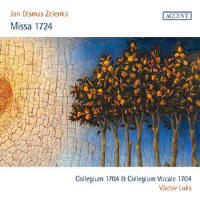Texte paru dans: / Appeared in: |
|
|
Outil de traduction (Très approximatif) |
|
|
Reviewer: David Vickers This imaginary Mass is constructed from motley liturgical pieces created for various unknown occasions during the first half of the 1720s. Václav Luks’s helpful note explains that some of the material crops up in different forms in Zelenka’s other works. ‘Christe eleison’ is paraphrased from a Miserere (1722), and the second ‘Kyrie’ (repeated for ‘Dona nobis pacem’) is a chromatic double fugue later adjusted in a Requiem for Augustus the Strong (1733). The fabulous musicmaking does these variants and rarities ample justice. Collegium Vocale 1704’s arching phrases ebb and flow, with eloquent leaning upon Zelenka’s rich harmonic suspensions and a cultivated blend between all strands of textures. The excellent orchestra pay keen attention to sonorities and rhetorical vitality. Dated 1724, the Gloria is extensively reworked from Zelenka’s own early Missa Judica me (1714), also with prominence given to the new addition of trombones. The springy opening, replete with oboes and vigorous gestures, has impressively balanced interplay between soloists, full choir and the orchestra’s energy and élan. Sudden switches between sentimental slow moments and lively Italianate quick-fire passagework in the aria ‘Laudamus te’ require gentle fluidity and declamatory fervour from the tenor Václav Čižek. The duet ‘Qui tollis’ is sung delicately by the soprano Jeanne Mendoche and alto Aneta Petrasová, accompanied tastefully by two lutes, chamber organ, and three trombones that play with dexterity and gravitas. There is more than a whiff of Lotti in a short yet harmonically astounding ‘Qui sedes’, and the convivial ‘Quoniam’ is sung suavely by the bass Tomáš Šelc. A concise eight-voice double-choir Credo (c1724) is packed densely with inventive counterpoint and colours, especially its quirky concluding ‘Amen’. It is tricky to predict where Zelenka is aiming to take us during a strange ‘Osanna’ fugue that ends the Sanctus – but a fascinating contrast of function and temperament is provided by the straightforwardness of a compact Benedictus interpolated into Zelenka’s copy of a Mass by Giovanni Pisani (perhaps in the early 1730s). The afterpiece Salve regina is preserved only in a copy made by Bach’s Leipzig successor Gottlob Harrer, and it is a parody of a canzon from Frescobaldi’s Fiori musicali (1635); the knowingly archaic idiom ensures that Luks’s selection of rarities covers multiple facets of Zelenka’s complex musical personality. |
|



